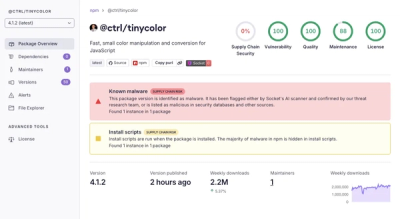
Research
/Security News
Popular Tinycolor npm Package Compromised in Supply Chain Attack Affecting 40+ Packages
Malicious update to @ctrl/tinycolor on npm is part of a supply-chain attack hitting 40+ packages across maintainers
.. role:: pythoncode(code) :language: python
####### BoARIO ####### |build-status| |black| |contribute| |licence| |pypi| |pythonv| |joss|
.. |build-status| image:: https://img.shields.io/github/actions/workflow/status/spjuhel/boario/CI.yml :target: https://github.com/spjuhel/BoARIO/actions/workflows/CI.yml :alt: GitHub Actions Workflow Status .. |black| image:: https://img.shields.io/badge/code%20style-black-000000 :target: https://github.com/psf/black :alt: Code Style - Black .. |contribute| image:: https://img.shields.io/badge/contributions-welcome-brightgreen.svg?style=flat :target: https://github.com/spjuhel/BoARIO/issues :alt: Contribution - Welcome .. |licence| image:: https://img.shields.io/badge/License-GPLv3-blue :target: https://www.gnu.org/licenses/gpl-3.0 :alt: Licence - GPLv3 .. |pypi| image:: https://img.shields.io/pypi/v/boario :target: https://pypi.org/project/boario/ :alt: PyPI - Version .. |pythonv| image:: https://img.shields.io/pypi/pyversions/boario :target: https://pypi.org/project/boario/ :alt: PyPI - Python Version .. |joss| image:: https://joss.theoj.org/papers/71386aa01a292ecff8bafe273b077701/status.svg :target: https://joss.theoj.org/papers/71386aa01a292ecff8bafe273b077701 :alt: Joss Status
BoARIO : The Adaptative Regional Input Output model in python.
.. _Documentation Website: https://spjuhel.github.io/BoARIO/boario-what-is.html
Indirect impact modeling is tied to a lot of uncertainties and complex dynamics.
Any results produced with BoARIO should be interpreted with great care. Do not
hesitate to contact the author when using the model !
BoARIO, is a python implementation project of the Adaptative Regional Input Output (ARIO) model [Hal13_].
Its objectives are to give an accessible and inter-operable implementation of ARIO, as well as tools to visualize and analyze simulation outputs and to evaluate the effects of many parameters of the model.
This implementation would not have been possible without the Pymrio_ module and amazing work of [Sta21_].
It is still an ongoing project (in parallel with a PhD project).
.. _Sta21: https://openresearchsoftware.metajnl.com/articles/10.5334/jors.251/
.. _Hal13: https://doi.org/10.1111/j.1539-6924.2008.01046.x
.. _Pymrio: https://pymrio.readthedocs.io/en/latest/intro.html
You can find most academic literature using ARIO or related models here <https://spjuhel.github.io/BoARIO/boario-references.html>_
ARIO stands for Adaptive Regional Input-Output. It is an hybrid input-output / agent-based economic model,
designed to compute indirect costs from economic shocks. Its first version dates back to 2008 and has originally
been developed to assess the indirect costs of natural disasters [Hal08_].
In ARIO, the economy is modelled as a set of economic sectors and a set of regions. Each economic sector produces its generic product and draws inputs from an inventory. Each sector answers to a total demand consisting of a final demand (household consumption, public spending and private investments) of all regions (local demand and exports) and intermediate demand (through inputs inventory resupply). An initial equilibrium state of the economy is built based on multi-regional input-output tables (MRIOTs).
For a more detailed description, please refer to the Mathematical documentation_ of the model.
Multi-Regional Input-Output tables (MRIOTs) are comprehensive economic data sets that capture inter-regional trade flows, production activities, and consumption patterns across different regions or countries. These tables provide a detailed breakdown of the flows of goods and services between industries within each region and between regions themselves. MRIOTs are constructed through a combination of national or regional input-output tables, international trade data, and other relevant economic statistics. By integrating data from multiple regions, MRIOTs enable the analysis of global supply chains, international trade dependencies, and the estimation of economic impacts across regions. However, they also come with limitations, such as data inconsistencies across regions, assumptions about trade patterns and production technologies, and the challenge of ensuring coherence and accuracy in the aggregation of data from various sources.
.. _Mathematical documentation: https://spjuhel.github.io/BoARIO/boario-math.html
.. _Hal08: https://doi.org/10.1111/risa.12090
You can install BoARIO from pip with:
.. code:: console
pip install boario
Or from conda-forge using conda (or mamba):
.. code:: console
conda install -c conda-forge boario
The full source code is also available on Github at: https://github.com/spjuhel/BoARIO
More info in the installation <https://spjuhel.github.io/BoARIO/boario-installation.html>_ page of the documentation.
In a nutshell, BoARIO takes the following inputs :
a (possibly Environmentally Extended) Multi-Regional IO table (such as EXIOBASE 3_ or EORA26) in the form of an pymrio.IOSystem object, using the Pymrio python package. Please reference the Pymrio documentation <https://github.com/IndEcol/pymrio>_ for details on methods available to pymrio objects.
multiple parameters which govern the simulation,
event(s) description(s), which are used as the perturbation to analyse during the simulation
And produces the following outputs:
the step by step, sector by sector, region by region evolution of most of the variables involved in the simulation (production, demand, stocks, ...)
aggregated indicators for the whole simulation (shortages duration, aggregated impacts, ...)
.. _EXIOBASE 3: https://www.exiobase.eu/
.. _EORA26: https://worldmrio.com/eora26/
See Boario quickstart <https://spjuhel.github.io/BoARIO/boario-tutorials.html>_.
This model is part of my PhD on the indirect impact of extreme events.
This work was supported by the French Environment and Energy Management Agency
(ADEME_).
.. image:: https://raw.githubusercontent.com/spjuhel/BoARIO/master/imgs/Logo_ADEME.svg?sanitize=true :width: 400 :alt: ADEME Logo
.. _ADEME: https://www.ademe.fr/
All contributions <https://spjuhel.github.io/BoARIO/development.html>_ to the project are welcome !
I would like to thank Vincent Viguie, Fabio D'Andrea my PhD supervisors as well as Célian Colon, Alessio Ciulo and Adrien Delahais for their inputs during the model implementation.
FAQs
BoARIO : The Adaptative Regional Input Output model in python.
We found that boario demonstrated a healthy version release cadence and project activity because the last version was released less than a year ago. It has 1 open source maintainer collaborating on the project.
Did you know?

Socket for GitHub automatically highlights issues in each pull request and monitors the health of all your open source dependencies. Discover the contents of your packages and block harmful activity before you install or update your dependencies.

Research
/Security News
Malicious update to @ctrl/tinycolor on npm is part of a supply-chain attack hitting 40+ packages across maintainers

Security News
pnpm's new minimumReleaseAge setting delays package updates to prevent supply chain attacks, with other tools like Taze and NCU following suit.

Security News
The Rust Security Response WG is warning of phishing emails from rustfoundation.dev targeting crates.io users.